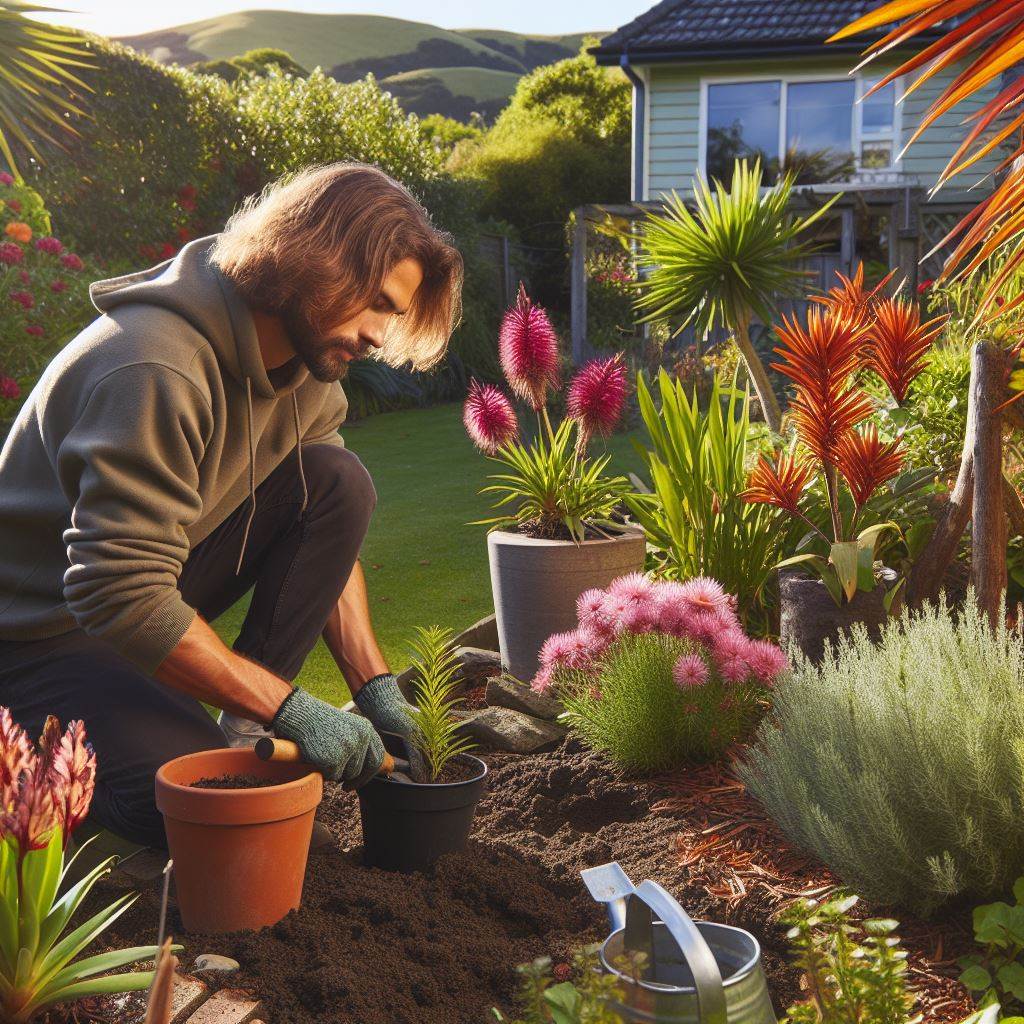Introduction
Rock gardening in New Zealand offers an opportunity to create beautiful landscapes using rocks and alpine plants.
Rock gardening is the art of creating gardens utilizing rocks as a prominent feature.
It involves arranging rocks in a visually appealing manner and planting alpine plants that thrive in rocky conditions.
Rock gardening has gained popularity in New Zealand due to the country’s unique landscape.
The geographical features of the country, such as mountains, cliffs, and rocky coastlines, provide ample inspiration for rock garden designs.
New Zealand’s diverse climate also allows for a wide range of alpine plants to flourish in rock gardens.
One of the main advantages of rock gardening in New Zealand is the low maintenance it requires.
Rock gardens are designed to mimic natural alpine environments, and the use of native plants means they are well adapted to the local conditions.
This results in reduced water requirements and a minimal need for fertilizers and pesticides.
In addition to being low maintenance, rock gardens also offer visual interest and variety.
The combination of rocks of different shapes, sizes, and colors, along with the vibrant alpine plants, creates a unique and dynamic landscape.
Rock gardens can be crafted to fit any sized space, from small urban gardens to larger rural properties.
Rock gardening in New Zealand allows gardeners to connect with nature and create a harmonious balance between the built environment and the natural world.
It provides an opportunity to showcase the beauty of rocks and alpine plants, while also conserving water and reducing maintenance efforts.
Whether you are an experienced gardener or a beginner, rock gardening in New Zealand offers endless possibilities for creativity and enjoyment.
Planning a rock garden
Planning a rock garden is an exciting endeavor that involves a series of thoughtful steps to ensure its creation harmonizes with the surrounding landscape and meets your aesthetic preferences.
Let’s delve deeper into each stage of this transformative process.
Choosing the right location
Firstly, choosing the right location sets the foundation for your rock garden’s success. Consider aspects such as sunlight exposure, existing vegetation, and space availability.
Assessing these factors will help determine the optimal spot for your garden, ensuring that plants and rocks thrive in their new environment.
Assessing soil and drainage conditions
Once a location is selected, a comprehensive assessment of the soil and drainage conditions is paramount.
Soil composition, pH levels, and drainage patterns play a crucial role in determining which plants will flourish and which rocks will integrate seamlessly into the landscape.
Conduct soil tests and observe water flow after rainfall to gather essential information for plant and rock selection
Determining the style and theme of the garden
With the groundwork laid, it’s time to explore the creative aspect of planning your rock garden.
Define the style and theme you envision, drawing inspiration from natural landscapes, architectural elements, or personal preferences.
Whether you aspire to create a tranquil Japanese-inspired Zen garden or a vibrant alpine rockery, clarifying your vision will guide subsequent decisions.
Selecting suitable rocks and plants
Selecting suitable rocks and plants is a pivotal step in bringing your vision to life.
Rocks serve as the backbone of your garden, providing structure, texture, and visual interest.
Consider factors such as size, shape, color, and texture when choosing rocks, aiming for a cohesive yet dynamic composition.
Similarly, choose plants that thrive in the chosen environment and complement the overall theme of your garden.
Pay attention to factors such as height, foliage texture, bloom color, and seasonal interest to create a diverse and visually captivating landscape.
As you embark on the journey of planning your rock garden, remember that patience and creativity are key.
Take time to experiment with different rock arrangements and plant combinations, refining your design until it reflects your unique vision.
With careful planning and attention to detail, you’ll create a stunning rock garden that transforms your outdoor space into a sanctuary of natural beauty and serenity.
Essential tools and materials for rock gardening
Rock gardening is a delightful way to add a touch of rugged beauty to your backyard. To create a successful rock garden in New Zealand, you will need a range of essential tools and materials.
In this section, we will explore the necessary tools and materials for rock gardening and how they can help you achieve your desired results.
List of Necessary Tools
- Shovels: A sturdy shovel is a must-have tool for rock gardening. It will help you dig holes for plants and move rocks around.
- Rakes: Rakes are essential for leveling the soil and removing debris from your rock garden.
- Pruners: Pruning is crucial for maintaining the health and shape of plants in your rock garden. Invest in a good pair of pruners for this task.
- Trowels: Trowels are useful for planting small herbs or flowers in tight spots between rocks.
- Gloves: Protect your hands from rough rocks, thorns, and splinters with a pair of durable gardening gloves.
- Wheelbarrow: A wheelbarrow will come in handy when transporting rocks, soil, or other materials around your garden.
Other Materials
- Landscape Fabric: Use landscape fabric to suppress weeds and prevent them from taking over your rock garden. It also helps in retaining moisture.
- Soil Amendments: To ensure optimal plant growth, add soil amendments such as compost, peat moss, or perlite to improve drainage and fertility.
- Mulch: Applying a layer of mulch between rocks helps conserve moisture and control weed growth while providing an attractive finishing touch.
- Rocks: Collect an assortment of rocks of various sizes and shapes to create visual interest and naturalistic formations in your rock garden.
- Gravel or Sand: Use gravel or sand as a base for your rock garden to improve drainage and create a stable foundation for your plants.
- Plants: Choose plants native to New Zealand as they are well-suited to the local environment and will thrive in your rock garden.
Now, let’s explore how to utilize essential tools and materials for your rock garden in New Zealand.
A shovel digs holes for plants and creates pockets between rocks. Rakes level soil and remove debris.
Pruners maintain plant health by trimming dead branches. Use a trowel for planting in tight spaces.
Protect your hands with gloves. A wheelbarrow efficiently transports heavy materials. Landscape fabric reduces weed growth.
Soil amendments balance nutrients. Mulch retains moisture and prevents weeds. Choose native rocks and plants.
With these tools and materials, you’re ready to design your rock garden oasis in New Zealand.
Read: Electrical Code Updates 2024: What NZ Needs to Know
Building a rock garden
Building a rock garden is a rewarding project that requires careful planning and execution to achieve a visually stunning and harmonious outdoor space.
Let’s delve into the essential steps and considerations involved in creating your rock garden oasis.
Personalized Career Consulting
Unlock your potential with expert career advice tailored to your goals. Get personalized guidance and actionable steps toward your dream career in New Zealand.
Get StartedSteps for preparing the site
Firstly, before diving into the placement of rocks, it’s crucial to prepare the site properly. Begin by removing any existing vegetation, such as grass or weeds, to create a blank canvas.
Level the ground to ensure a smooth and even surface for the rocks to rest upon. This initial step sets the foundation for the rest of your rock garden project.
Guidelines for placing and arranging rocks
Once the site is prepared, it’s time to start placing and arranging the rocks. Consider the size, shape, and texture of the rocks as you position them, aiming for a naturalistic and balanced layout.
Larger rocks can serve as focal points, while smaller ones can be nestled among them to create depth and visual interest.
Experiment with different arrangements until you find a composition that feels harmonious and complements the surrounding landscape.
Tips for creating visual interest with various rock sizes and shapes
To add visual intrigue to your rock garden, vary the sizes and shapes of the rocks throughout the space. Incorporate boulders, cobbles, and pebbles of different dimensions to create texture and contrast.
Pay attention to the natural flow of the terrain and mimic it in your rock placement, creating visual pathways that draw the eye and invite exploration.
Importance of creating well-drained soil pockets amongst the rocks
In addition to the placement of rocks, it’s essential to create well-drained soil pockets amongst them to provide an optimal growing environment for plants.
Incorporate coarse gravel or sand into the soil to improve drainage and prevent waterlogging, ensuring the health and vitality of your plants.
These soil pockets will also add depth and dimension to your rock garden, creating pockets of greenery amidst the rocky landscape.
Lastly, consider the overall aesthetic and theme of your rock garden as you plan and design.
Whether you’re aiming for a rugged alpine retreat or a tranquil Japanese-inspired Zen garden, let your creativity and personal style guide you.
By following these steps and considerations, you can create a captivating rock garden that enhances your outdoor space and provides a serene retreat for relaxation and contemplation.
Read: Women in Electrical Trades: NZ’s Growing Trend
Selecting plants for a rock garden in New Zealand
Creating a rock garden in New Zealand allows for the selection of a variety of plants that can thrive in this unique environment.
With the country’s diverse climate and terrain, it’s important to choose plants that are well-suited to rocky and dry conditions.
Native New Zealand plants that thrive in rock gardens
When selecting plants for your rock garden, consider native New Zealand species that have adapted to the country’s specific climate.
These plants are often more resilient and require less maintenance. Some recommended native plants include:
- Kōwhai (Sophora microphylla): This native tree produces stunning golden flowers and can tolerate dry conditions.
- Ti kouka (Cordyline australis): Also known as cabbage tree, it has a sculptural appearance and is highly adaptable.
- Hebe: These evergreen shrubs come in various sizes and colors, adding beauty and texture to any rock garden.
- Tussock grasses: Chionochloa species, such as Chionochloa rubra and Chionochloa flavicans, offer a natural and rustic look.
- Rewarewa (Knightia excelsa): This tree has distinctive red flowers, attracting native birds to your rock garden.
Drought-tolerant plants that can handle the country’s climate
In addition to native plants, consider including drought-tolerant species in your rock garden.
New Zealand experiences periods of dry weather, especially in certain regions. Here are some suggestions for plants that can handle these conditions:
- Lavender (Lavandula angustifolia): Its fragrant flowers and silver foliage make it a popular choice for rock gardens.
- Sedums: These succulent plants come in many colors and shapes, thriving in dry and rocky areas.
- Echeverias: These rosette-forming succulents add a touch of elegance to any rock garden.
- Agapanthus: These hardy plants produce stunning clusters of blue or white flowers and can withstand dry spells.
- Koromiko (Hebe stricta): This tough shrub produces small white flowers and can tolerate dry and windy conditions.
The use of alpine and succulent plants in rock gardens
If you’re looking to create a rock garden with a more alpine feel, incorporating alpine plants is a great choice. These plants are typically smaller, hardy, and adapted to high altitudes.
Some suitable alpine plants for a New Zealand rock garden include:
- Mountain daisies (Celmisia species): These beautiful native plants have silver foliage and daisy-like flowers.
- Gentians: These vibrant blue flowers add a pop of color to rocky environments.
- Ranunculus lyallii: Also known as Mount Cook buttercup, it has large white flowers and thrives in alpine regions.
- Phormium cookianum: This flax-like plant is native to alpine areas and adds architectural interest to the rock garden.
- Libertia species: These grass-like plants have striking orange or yellow foliage, perfect for rock gardens.
Creating a rock garden in New Zealand allows you to showcase a diverse array of plants, from native species to alpine treasures.
By carefully selecting plants that can thrive in rocky and dry conditions, you’ll be able to create a stunning and low-maintenance garden that thrives in the country’s unique climate.
Read: Apprenticeships in Electrical Work: NZ Focus

Maintaining a Rock Garden
Maintaining a rock garden requires regular care and attention to keep it thriving and looking beautiful. Here are some essential guidelines to help you maintain your rock garden effectively:
- Clear debris: Remove dead leaves, weeds, and fallen branches regularly to keep your rock garden clean.
- Inspect plants: Check your plants for any signs of disease or pests and take appropriate measures if necessary.
- Prune correctly: Prune your plants to control their growth and maintain their shape, ensuring they don’t overshadow other plants.
- Fertilize properly: Use a slow-release granular fertilizer to provide essential nutrients to your plants without overfeeding them.
- Water adequately: Water your rock garden deeply but infrequently, ensuring the water reaches the roots.
- Consider the weather conditions: Adjust your watering frequency based on rainfall and temperature.
- Protect from extreme weather: Shield your plants during extreme weather conditions like strong winds and heavy downpours.
- Prevent erosion: Use rocks strategically to prevent soil erosion and create natural barriers.
- Weed control: Regularly weed your rock garden to keep it free from unwanted plants and maintain its aesthetic appeal.
- Monitor drainage: Ensure proper drainage in your rock garden by using well-draining soil and positioning rocks to guide water flow.
Watering and Fertilizing Guidelines
Proper watering and fertilizing are crucial for the health and vitality of plants in your rock garden. Follow these guidelines to ensure your plants thrive:
- Water deeply: Give your plants a thorough watering, ensuring the moisture reaches the roots.
- Avoid overwatering: Allow the topsoil to dry out slightly before watering again to prevent waterlogging.
- Use organic fertilizers: Opt for slow-release organic fertilizers to provide long-term nourishment to your plants.
- Apply fertilizers sparingly: Avoid over-fertilizing, as it can lead to excessive growth and weak plants.
- Follow recommended doses: Read the instructions on the fertilizer packaging and apply accordingly.
- Consider plant needs: Different plants have different nutrient requirements, so choose fertilizers accordingly.
- Apply during the growing season: Fertilize your rock garden plants during their active growth periods for maximum benefit.
Pruning and Trimming Suggestions for Different Types of Plants
Proper pruning and trimming techniques vary depending on the type of plants in your rock garden. Here are some general suggestions:
Transform Your Career with a Professional CV and Cover Letter
Stand out to employers with an ATS-optimized resume and tailored cover letter designed to match your dream role. Let us craft your job application materials for success!
Get Started- Flowering plants: Prune after flowering to maintain their shape and stimulate new growth.
- Evergreens: Prune in early spring to remove dead or damaged branches and maintain a compact form.
- Groundcovers: Trim regularly to keep them neat and prevent them from becoming invasive.
- Ornamental grasses: Cut back in late winter or early spring before new growth emerges.
- Succulents: Remove dead or wilted leaves to promote the overall health and appearance of the plants.
- Shrubs: Prune lightly throughout the growing season to control their size and shape.
Weed Control Methods Specific to Rock Gardens
Keeping weeds at bay is essential to maintain the beauty of your rock garden. Here are some effective weed control methods:
- Mulching: Apply a layer of organic mulch, such as shredded bark or compost, to suppress weed growth.
- Hand pulling: Regularly inspect your rock garden and remove weeds by hand, including the roots.
- Use weed barriers: Install landscape fabric beneath the rocks to prevent weed growth.
- Encourage groundcovers: Plant low-growing groundcovers to fill gaps and minimize weed establishment.
- Apply herbicides sparingly: If all else fails, use herbicides labeled for use in rock gardens, following instructions carefully.
Protecting Plants During Extreme Weather Conditions
Extreme weather conditions can pose a threat to your rock garden plants. Here’s how to protect them:
- Extreme cold: Cover sensitive plants with frost blankets or burlap to protect them from freezing temperatures.
- Strong winds: Use windbreaks such as trellises or fences to shield your plants from excessive wind exposure.
- Heavy rain: Create small trenches or channels to redirect water away from your rock garden and prevent waterlogging.
- Drought: Apply a layer of organic mulch to conserve moisture and provide insulation during dry spells.
- Hailstorms: Cover delicate plants with overturned buckets or plant them under taller plants for natural protection.
By following these maintenance guidelines, your rock garden will thrive and provide a delightful display of nature’s beauty.
Read: The Impact of Technology on NZ Electricians
Showcasing successful rock gardens in New Zealand
New Zealand is renowned for its breathtaking landscapes, and rock gardens are no exception.
These meticulously designed outdoor spaces combine the rugged beauty of rocks with the delicate artistry of gardening.
In this section, we will explore some of the most successful rock gardens in New Zealand, highlighting notable examples from different regions.
The Southern Alpine Rock Garden
Located in the Southern Alps, this rock garden is a masterpiece of subalpine flora.
Its design principles emphasize the use of native plants, strategically placed rocks, and natural drainage systems.
The unique features of this garden include cascading waterfalls, carefully curated pathways, and vibrant alpine flowers.
Visitors to this garden can experience the serene beauty of the mountains while being surrounded by a diverse array of flora.
The Coastal Rock Garden
Moving to the coast, we discover a different type of rock garden that thrives in the unique coastal conditions.
This garden showcases plants that can withstand salt spray, strong winds, and sandy soil.
The design principles employed here focus on creating sheltered pockets and using rocks to anchor plants.
Visitors to this garden will be inspired by the resilience of these coastal plants and their ability to create a lush and beautiful oasis amidst the harsh coastal environment.
The Subtropical Rock Garden
Heading north, we encounter a rock garden that celebrates the lushness of subtropical flora.
This garden utilizes a combination of large boulders and smaller rocks to create a naturalistic setting that complements the surrounding vegetation.
With vibrant foliage and exotic blooms, this garden is a feast for the senses.
Visitors to this garden will be transported to a tropical paradise and can seek inspiration for their own subtropical rock gardens.
The Mountain Rock Garden
Nestled in the heart of the mountain ranges, this rock garden is a testament to the resilience of alpine plants.
The design principles used here combine the use of rocks, gravel, and carefully selected alpine plants to create a landscape that mirrors the surrounding peaks and valleys.
Visitors to this garden will be captivated by the hardiness of these plants and the picturesque views they offer.
These four rock gardens represent some of the best examples in New Zealand, showcasing the diversity and beauty of this gardening style.
Whether you are a seasoned gardener or an aspiring enthusiast, these gardens provide a wealth of design ideas and inspiration.
So, plan a visit or explore these gardens virtually to witness the magic of rock gardening in New Zealand firsthand.
Conclusion
In closing, rock gardening in New Zealand offers numerous benefits and brings immense joy to enthusiasts.
The unique landscapes and diverse flora make it an ideal location for creating stunning rock gardens.
By cultivating a rock garden, individuals can enjoy the therapeutic effects of spending time in nature and nurturing plants.
Rock gardens also promote biodiversity and provide habitats for local wildlife.
Starting your own rock garden is a fulfilling endeavor that allows you to express your creativity and connect with nature.
Boost Your Career with a Standout LinkedIn Profile
Attract recruiters and expand your network with a fully optimized LinkedIn profile tailored to highlight your strengths and professional goals. Let your profile open doors to new opportunities!
Get OptimizedBy researching suitable plant species, learning about rock formations, and implementing proper drainage, anyone can create a beautiful rock garden.
Remember, it’s important to regularly maintain your rock garden by removing weeds, pruning plants, and ensuring proper watering.
So why not take the plunge and embark on this exciting journey of rock gardening? The rewards are truly worth it.
Experience the satisfaction of watching your rock garden flourish and become a sanctuary for both plants and wildlife.
Start small, learn from your mistakes, and watch your passion for rock gardening grow along with your garden.
In closing, rock gardening in New Zealand offers endless possibilities for creating a unique, tranquil, and vibrant space.
Embrace the beauty and serenity of rock gardening and let nature’s wonders enhance your life.
So, go ahead, grab your tools, and start your rock garden adventure now!




